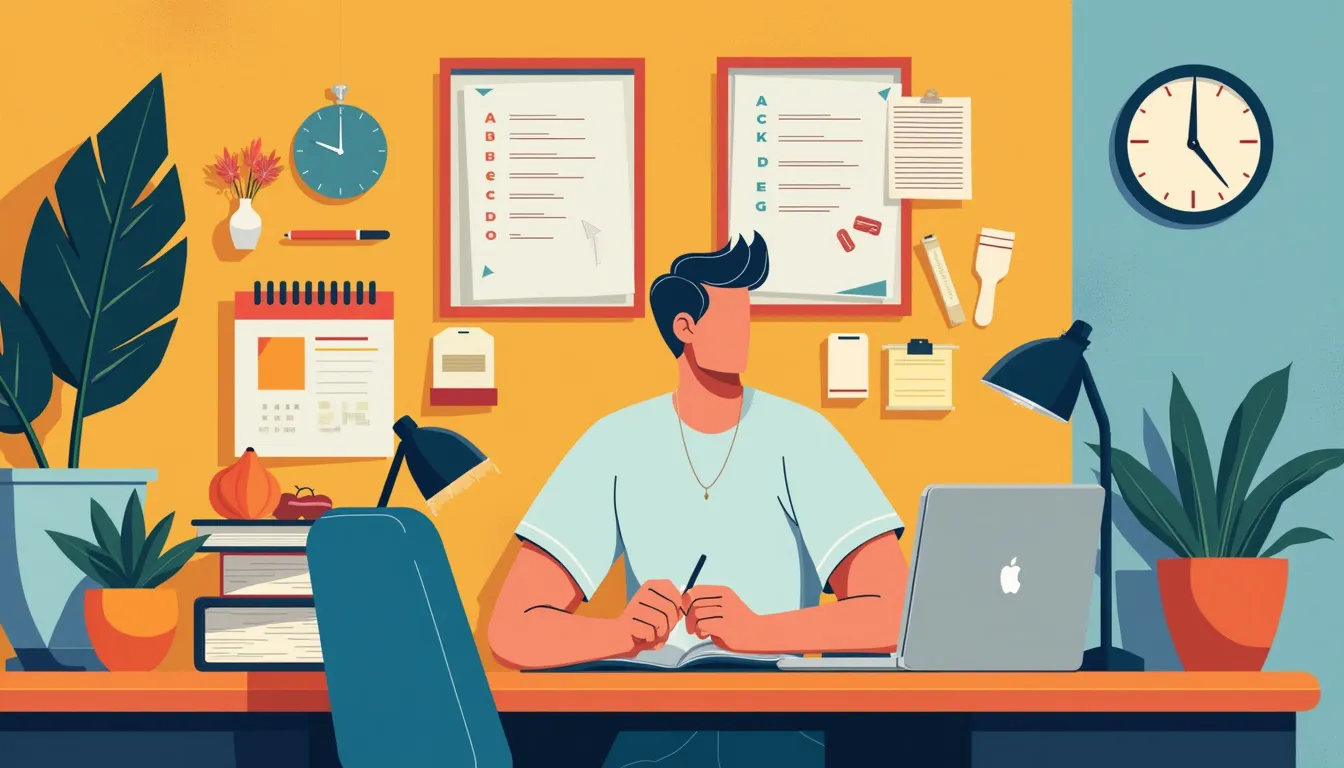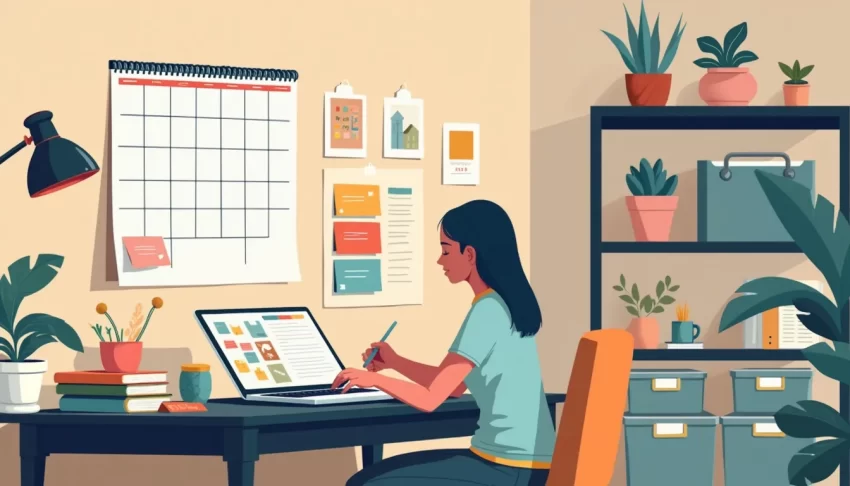Living with ADHD often feels like navigating a labyrinth without a map; each twist and turn presents unique challenges that can disrupt everyday life. Attention Deficit Hyperactivity Disorder (ADHD) is a neurodevelopmental condition that affects millions worldwide, manifesting in diverse ways such as impulsivity, inattention, and hyperactivity. The impacts of ADHD permeate almost every aspect of daily routine, from completing household chores to focusing at work. However, managing ADHD in daily life is not only possible but can be made significantly easier with effective strategies tailored to individual needs.
Understanding the importance of effective management strategies can’t be overstated. ADHD might be an integral part of who you are, but it doesn’t have to define your day-to-day existence. Implementing structured routines, breaking tasks into manageable steps, and making healthy lifestyle choices are just a few methods that can bring substantial improvements to the lives of those navigating the complexities of ADHD. The goal is not perfection but progress; small, incremental steps towards a more organized and fulfilling life.
This article will delve into a variety of actionable strategies to help manage ADHD in daily life. We will explore the benefits of establishing a structured routine, providing practical tips for creating and maintaining daily schedules, and recommending useful tools and apps. Moreover, we will share techniques to tackle daily tasks efficiently, such as breaking them into smaller steps, using timers and reminders, and minimizing distractions. Finally, embracing healthy lifestyle choices, including regular physical activity, proper nutrition, and good sleep hygiene, will also be discussed. By adopting these strategies, anyone can better navigate the intricacies of life with ADHD, turning potential chaos into harmony.
Introduction to Managing ADHD in Daily Life
Attention Deficit Hyperactivity Disorder (ADHD) is a neurodevelopmental disorder characterized by symptoms of inattention, hyperactivity, and impulsivity. These symptoms can significantly impact various aspects of daily life, including work performance, relationships, and overall well-being. Understanding the impacts of ADHD is crucial to effectively manage it.
Overview of ADHD and Its Impacts
ADHD affects both children and adults, although the presentation of symptoms can vary with age. In children, hyperactivity and impulsivity tend to be more prominent, while in adults, inattention, disorganization, and difficulty with time management often come to the forefront. Regardless of age, individuals with ADHD may find it challenging to sustain attention, complete tasks, and maintain an organized life. This can lead to a cycle of frustration, low self-esteem, and heightened stress.
For example, I remember a time when I was working on an important project. Despite knowing the deadlines, I struggled to keep track of tasks and prioritize my workload. My ADHD made it difficult to focus on any single task for extended periods. Consequently, I experienced stress and anxiety, which further hampered my productivity. This experience underscored the necessity of having effective management strategies in place for navigating daily life with ADHD.
Importance of Effective Management Strategies
Effective management strategies are vital for those with ADHD to lead fulfilling and productive lives. They help mitigate the adverse effects of the condition, enhancing one’s ability to focus, stay organized, and manage time efficiently. Without these strategies, daily tasks can become overwhelming, leading to cumulative stress and potential burnout. Additionally, these strategies promote self-confidence and reduce the frustration of constantly battling one’s own mind.
A friend of mine, Jane, also has ADHD. For years, she struggled with keeping her life in order until she implemented structured strategies. She began with simple interventions like setting goals, using planners, and breaking tasks into manageable steps. She noticed a marked improvement in her overall productivity and a significant reduction in her stress levels. Jane’s story is a testament to the power of effective management strategies in transforming daily life for individuals with ADHD.
Brief Preview of the Article’s Core Points
This article aims to provide comprehensive insights into managing ADHD in daily life. We will delve into various strategies, including establishing a structured routine, practical techniques for tackling daily tasks, and embracing healthy lifestyle choices.
The subsequent sections will discuss the benefits of structured routines and tips for creating and sustaining one. We will explore practical approaches such as breaking down tasks, using timers, and minimizing distractions to manage daily activities effectively. Lastly, we will highlight the importance of lifestyle choices, such as physical activity, nutrition, and sleep hygiene, in managing ADHD symptoms.
If you or someone you know is navigating life with ADHD, this article will offer valuable strategies and actionable advice to improve daily management of the condition. By incorporating these techniques, it’s possible to enhance focus, productivity, and overall well-being.
Remember, managing ADHD in daily life is not about striving for perfection but about finding consistent methods that work for you.

Establishing a Structured Routine
Creating and adhering to a structured routine is one of the most effective strategies for managing ADHD in daily life. A well-organized routine can provide a sense of predictability and stability, essential for individuals with ADHD who often face challenges with impulsivity, focus, and time management.
Benefits of Structure for ADHD Management
A structured routine brings multiple benefits for those managing ADHD. First and foremost, it helps in reducing anxiety and stress by eliminating the uncertainty of what comes next. An established schedule serves as a roadmap, breaking the day into manageable segments and making it easier to focus on one task at a time.
One notable example from my own life involves managing my professional responsibilities while overcoming the distractions posed by ADHD. By adhering to a structured routine, I found it much easier to maintain focus, meet deadlines, and deliver consistent results. This balance between work and personal time also greatly contributed to my overall well-being.
Tips for Creating and Maintaining a Daily Schedule
When it comes to creating a daily schedule, consider beginning with a simple framework that includes fixed times for waking up, meals, work, and sleep. Consistency is key. Here are a few tips to help you cultivate and maintain an effective routine:
- Start Small: Introduce changes gradually. Start with anchoring your day around a few key activities like morning routines and bedtime rituals.
- Prioritize Tasks: List your tasks based on their importance and deadlines. Use this list to plan your day, ensuring you allocate time for high-priority items first.
- Be Realistic: Recognize your limits. Overcommitting can lead to burnout, which is counterproductive. Allocate breaks and downtime between tasks to recharge.
- Stay Flexible: While consistency is important, allow some flexibility to accommodate unexpected events or changes, reducing frustration and stress.
For instance, I often schedule my most demanding tasks during my peak productivity hours, which for me are late morning and early afternoon. This allows me to leverage my optimal focus times and reserve less intensive tasks for when my energy naturally dips.
Use of Tools and Apps for Routine Management
Technology can be an invaluable ally for managing ADHD in daily life. Numerous tools and apps are available to help you stay organized and adhere to your schedule. Here are a few that have proven particularly useful:
- Calendar and Scheduling Apps: Apps like Google Calendar or Apple Calendar allow for easy scheduling and setting of reminders. Utilize color coding for different types of tasks to provide visual cues.
- Task Management Tools: Applications such as Todoist and Trello help in organizing tasks, setting priorities, and tracking progress. These tools are particularly effective for breaking larger tasks into smaller, manageable steps.
- Timer Apps: Tools like Focus@Will and Pomodoro Timer can help in maintaining concentration. They use timed work sessions followed by short breaks, which is excellent for sustaining focus without feeling overwhelmed.
Personally, I find Trello’s board system particularly beneficial because it allows me to visualize my projects and move tasks through different stages. This visual approach aligns with my preference for non-linear thinking, typical among those with ADHD.
By integrating these tools and strategies into your daily routine, you can harness the benefits of a structured schedule, significantly enhancing your ability to manage ADHD effectively.
While establishing these routines and using tools have formed the backbone of my success in both my professional life and personal well-being, the journey requires patience and persistence. Start small, remain flexible, and continuously iterate on what works best for your unique needs.

Practical Techniques for Daily Tasks
Managing ADHD in daily life can often feel like juggling multiple tasks at once while trying to stay focused. However, with the right strategies, we can make day-to-day activities more manageable. Here’s how to break down daily tasks effectively and stay on track.
Break Tasks into Manageable Steps
One of the more common challenges for individuals with ADHD is getting overwhelmed by large tasks. The key is to break them down into smaller, more manageable steps. Imagine you have a report to write. Instead of viewing it as one giant, overwhelming task, split it into smaller sections. Start with an outline, draft an introduction, write each subsection, and finally, review and revise. This approach not only makes the task seem less daunting but also provides a clear pathway to completion.
This technique, reminiscent of “chunking,” is particularly effective. I recall a project where I had to develop a comprehensive safety protocol for an AI system. By breaking the task into smaller steps—researching best practices, consulting with experts, drafting procedures, and refining details—I managed to complete it systematically, avoiding the overwhelm that might have arisen from looking at the project as a whole.
Utilize Timers and Reminders
Another powerful strategy for managing ADHD in daily life is using timers and reminders. Timers can create a sense of urgency and help maintain focus. The Pomodoro Technique, for instance, involves working for 25 minutes followed by a 5-minute break. After four sessions, you can take a longer break. This method not only keeps you engaged but also ensures regular intervals of rejuvenation.
Personal reminders can be equally beneficial. Setting alarms for regular intervals can help you stay on schedule with tasks and appointments. Personally, I utilize both analog tools, like sticky notes, and digital tools, such as calendar apps and smart assistants, to remind me of important meetings and deadlines. By integrating these reminders into my routine, I ensure that no critical task slips through the cracks.
Strategies for Minimizing Distractions
Distractions can be a significant hurdle in managing ADHD in daily life. Identifying and mitigating these distractions is essential for maintaining productivity. Here are a few tactics that have proven effective:
- Create a Distraction-Free Workspace: Designate a specific area for work or study that is free from common distractions like television, personal calls, and social media. If you work from home, make sure this space is separate from areas meant for relaxation.
- Use Noise-Cancelling Headphones: These can help mute background noises and create an environment more conducive to concentration. I’ve found these especially useful when working in shared spaces or noisy environments.
- Implement Digital Detoxes: Limiting screen time, especially on social media, can significantly reduce distractions. Apps designed to block certain websites or functionalities during work hours can also help maintain focus. During a recent weight loss journey, I realized that frequent social media browsing was not only a distraction but also a trigger for unhealthy snacking. By limiting my social media use, I improved both my concentration and my dietary habits.
Managing ADHD in daily life means leveraging practical techniques tailored to individual needs. Experiment with these strategies and observe what works best for you. Soon you’ll find a rhythm that minimizes overwhelm, maintains focus, and enhances productivity. Tackling ADHD may come with unique challenges, but with determination and the right strategies, overcoming them is entirely within reach.

Embracing Healthy Lifestyle Choices
Managing ADHD in daily life isn’t merely about creating routines or breaking tasks into smaller steps; it’s also fundamentally linked to embracing healthy lifestyle choices. A holistic approach that incorporates physical activity, nutritional mindfulness, and good sleep hygiene can significantly enhance focus, energy, and overall well-being for those managing ADHD.
Importance of Regular Physical Activity
One of the cornerstones of managing ADHD in daily life is regular physical activity. Exercise is not just beneficial for physical health, but it also has a profound impact on mental health and cognitive function. Numerous studies have shown that physical activity can help reduce symptoms of ADHD by increasing the levels of dopamine and norepinephrine in the brain, which play crucial roles in attention and focus.
Take, for instance, the story of Mark, a professional in his mid-thirties who struggled with ADHD. Mark found that incorporating a daily 30-minute run into his morning routine not only boosted his mood but also significantly improved his ability to concentrate at work. The rush of endorphins gave him a natural boost, making his mind sharper and more alert. For those looking to integrate exercise into their routines, start with a simple daily walk or explore activities you enjoy, such as dancing, swimming, or cycling. Consistency is key, so find what works best for you and stick with it.
Nutritional Tips for Improved Focus and Energy
What you consume has a direct impact on your brain function and energy levels, making nutrition an essential element in managing ADHD in daily life. Opting for a balanced diet rich in proteins, complex carbohydrates, fruits, and vegetables can stabilize energy levels and maintain focus throughout the day.
Consider the case of Sarah, a young entrepreneur diagnosed with ADHD. She noticed significant improvements in her attention span after making simple dietary adjustments. By reducing her intake of high-sugar snacks and processed foods, and instead incorporating more lean proteins, omega-3 fatty acids, and whole grains into her meals, Sarah experienced fewer energy dips and better sustained concentration. Foods like salmon, walnuts, eggs, blueberries, and leafy greens can be particularly beneficial. Trying a variety of foods to see what best supports your individual focus and energy levels is advisable.
Furthermore, staying hydrated is often overlooked but critically important. Dehydration can exacerbate symptoms of ADHD, leading to difficulties in concentration and irritability. Aim for at least eight glasses of water a day and consider incorporating other hydrating beverages, such as herbal teas, into your routine.
Sleep Hygiene and Its Role in Managing ADHD
Another vital aspect of managing ADHD in daily life is practicing good sleep hygiene. Sleep has a tremendous impact on cognitive functions, mood, and overall health. Many individuals with ADHD struggle with sleep-related issues, which can compound their symptoms. Prioritizing sleep is, therefore, essential.
Take the example of James, who found that his ADHD symptoms worsened whenever his sleep patterns were disrupted. Through a series of adjustments, such as establishing a consistent bedtime routine, creating a restful environment, and reducing screen time before bed, James managed to improve his sleep quality substantially. By going to bed and waking up at the same time every day, avoiding caffeine in the afternoon, and engaging in relaxing activities like reading or meditating before sleep, James was able to enhance his focus and reduce daytime drowsiness.
Consider using tools and technologies to aid sleep hygiene. White noise machines, blackout curtains, and apps that monitor and improve sleep patterns can be particularly useful. Creating a tranquil sleep environment that is cool, quiet, and dark can also foster better rest.
Embracing healthy lifestyle choices is a crucial element in managing ADHD in daily life. By incorporating regular physical activity, adopting a nutritious diet, and practicing good sleep hygiene, individuals can significantly mitigate the symptoms of ADHD, enhancing focus, energy, and overall quality of life. Small changes can lead to profound impacts, and each step taken towards a healthier lifestyle is a step towards better ADHD management.
As we navigate the multifaceted journey of managing ADHD in daily life, it becomes clear that a strategic approach can make a world of difference. ADHD, with its complexities and challenges, calls for a robust management plan that not only addresses daily tasks but also enhances overall well-being.
Establishing a structured routine stands at the forefront of effective ADHD management. The stability and predictability that a well-organized schedule provides can significantly mitigate the chaotic nature of ADHD. From using digital tools like apps to creating tangible visual schedules, these strategies help anchor our days and reduce the mental clutter that often accompanies this condition.
When it comes to tackling daily tasks, breaking down projects into manageable steps is a game-changer. This method not only makes large tasks less daunting but also provides a steady stream of accomplishments to boost morale. Coupled with the use of timers and reminders, these techniques keep us anchored to the present, ensuring that we stay on track. Additionally, crafting environments that minimize distractions can help in retaining focus and maximizing efficiency.
Embracing healthy lifestyle choices is another pillar of effective ADHD management. Regular physical activity isn’t just good for the body; it’s a potent tool for enhancing concentration and reducing hyperactivity. Nutritional choices play a significant part too—foods rich in protein, omega-3 fatty acids, and complex carbohydrates can help sustain energy levels and improve cognitive function. And let’s not forget sleep hygiene. Prioritizing restful, quality sleep is crucial for brain function, mood regulation, and overall energy levels, all of which are vital for handling ADHD symptoms effectively.
As someone who has spent a lifetime grappling with both the challenges of ADHD and the passion for systematizing solutions, I can attest to the power of these strategies. Moreover, introducing a touch of humor and compassion into our routines reminds us that perfection is not the goal; progress is.
In closing, the call to action is clear: Equip yourself with these strategies, personalize them to fit your life, and most importantly, be patient with yourself. Managing ADHD in daily life is a continuous process of learning, adapting, and growing. Stay committed, and remember that both setbacks and triumphs are part of this journey. Each step forward, no matter how small, is a victory worth celebrating.
Support Us: Check out our recommended products on Amazon.

